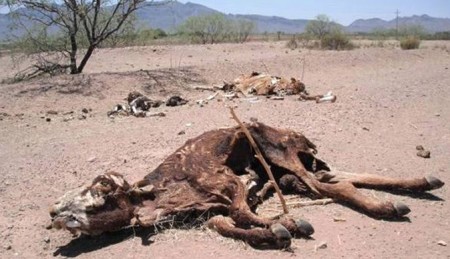Drought 2019: Two-thirds of crops wilt, livestock fatalities rise
Mbongeni Mguni | Friday April 5, 2019 12:54


“Go maswe bagaetsho.”
Agriculture minister, Patrick Ralotsia, who is also a prominent farmer with 300 hectares in the Kanye area, appears to be running out of adjectives to describe the latest cropping season disaster.
“Even at my own farm, everything is 100% down. There’s nothing, nothing at all. It’s finished,” he tells Mmegi.
The minister is just one of tens of thousands of farmers who have faithfully planted crops each season in the past five years and watched their investments wilt into dry stalks under an unforgiving sun and miserly clouds. Prolonged mid-season dry spells, late onset of rains and erratic patterns have become the order of the day, while the heatwaves that now visit each season drive away even the most stubbornly hopeful of farmers.
The cause of the problem is the El Nino phenomena, a routine climate event, which causes droughts and floods in Southern Africa. Due to climate change, El Nino’s frequency has increased in recent years from once in about seven years, to nearly every other year.
The only break farmers had was in the 2016-2017 season when Cyclone Dineo lashed the country, filling up a Gaborone Dam that had been dried by droughts since 2014 and leading to once-off bumper harvests in most areas.
In 2017-2018, the year after Dineo landed and left, the ‘regular programming’ resumed, with the drought pushing down production and local farmers harvesting just 66,093 tonnes of sorghum and white maize.
The national demand is about 300,000 tonnes of both, consisting of 120,000 tonnes of maize and about 80,000 tonnes of sorghum.
Botswana has never been fully self-sufficient in both and relies heavily on imports, done through local millers and the Botswana Agricultural Marketing Board (BAMB).
Still, local production, both by subsistence and commercial farmers, is critical to supporting the rural economy in terms of produce, incomes, jobs and reducing the weight on government social safety nets.
The 2018-2019 cropping season was expected to be poor, with the Meteorological Services Department confirming as early as September 2018 that El Nino was forming over the region.
What has shocked farmers, however, is the intensity of the situation and the pitifulness of the harvest.
Ralotsia and his experts are still finalising their estimates of the harvest, but already they reckon farmers will get only 40% or less of what they planted this season.
“Even more worrying is that major producing areas like Pandamatenga and Mosisedi have not been spared by the poor rains.
“In 2017-2018, 38,305 hectares were planted at Pandamatenga and 7,608 hectares at Mosisedi.
“In the current cropping season, the area planted for Pandamatenga is 10,140 hectares and 1,925 hectares for Mosisedi.
“There was a time at the beginning of the season when we thought things would be good, but now if you see what’s happening across our districts, you would be quite shocked.
“Most of the crops planted are stunted and already showing signs of wilting, while others have reached permanent wilting point.”
Two-thirds of the crops planted this season are sorghum, maize and to a lesser extent millet. The first two comprise national staples and at present, the BAMB’s stocks in the Strategic Grain Reserves can only last the country until July, after which more imports will be required.
In the kraals, livestock fatalities have been reported in areas like southern Kgalagadi, where just 30 millimetres of rain has fallen this year. Fatalities at the tail end of the rain season are unusual and a critical warning of severe drought, experts say.
Ralotsia is urging farmers to destock before it is too late.
“Little by little, people are realising that these animals are ‘money’.
“We should not allow money to be burnt in the sun.
“We must save it by taking livestock to abattoirs and reducing their numbers so that they help us take care of those that remain behind.
“This message is critical and we are taking it to farmers to say let’s salvage the situation.
“Even though it’s bad, we can still see some value here.”
In the cities and towns, however, people go about their business unperturbed by the perennial droughts. While most city dwellers have rural links and are aware of the disaster on the fields and kraals every season, they are insulated by the country’s traditional reliance on imports to supplement its cereal demand.
Botswana has traditionally paid its way out of the food security crises, with government pumping millions towards imports as well as support for vulnerable groups, children and subsidies for farmers.
However, the frequency of the droughts set against budget deficits in recent years, means government is having to dig deeper each year to support the economy through another failed season.
Each year, the government spends upwards of P600 million on the agricultural inputs programme for citizen farmers and for four out of the last five years, it has also spent up to P800 million on drought relief initiatives.
Already this season, millions of pula in expenses were incurred in extending the ploughing period due to the late onset of rains. More millions have been spent in providing a 25% subsidy for livestock feed, an initiative that this week was extended to June 30.
“We simply cannot afford to keep doing things the same way we have been doing them,” Ralotsia says.
“Climate change is manifesting itself in different ways such as drought, extreme heat and others.
“In recent years, when we say we had rains, we actually mean the drought was better than before!”
Government is fast-tracking a drought management strategy, incorporate climate change interventions, under which “planning will be drought compliant, crops will be drought compliant and livestock production will be drought compliant,” Ralotsia says.
In the meantime, the minister is getting ready to speed up food security interventions for vulnerable households.
“Nutritional deficiencies are likely to escalate,” he says, forlornly.
